Making fermented hot sauce is a unique method for preserving fresh peppers and other produce. Fermenting peppers is also a method for creating a hot sauce without the use of vinegar.
With a proper pH, this type of sauce can keep in the refrigerator for months, and I tend to believe the sauce only improves in flavor over time.
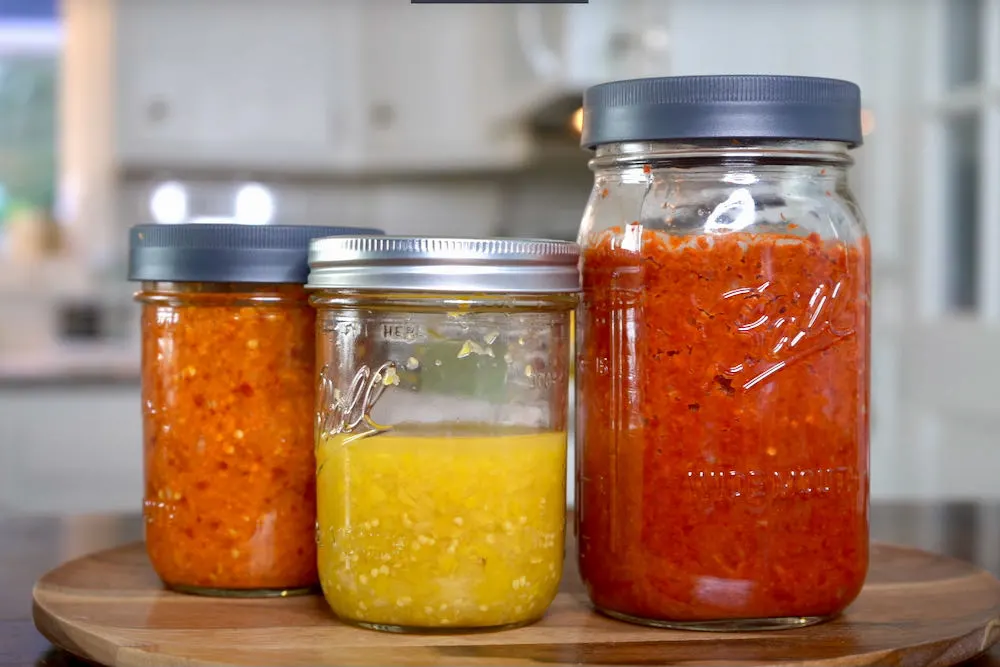
In this article:
- What is lactofermentation?
- Avoid potential risks
- Making fermented hot sauce (steps)
- What pH should it be?
- When is fermentation done?
- Fermented flavor
- How long does it last?
- Kahm yeast
What is Fermentation (Lactofermentation)?
Like it or not, bacteria is everywhere. For the folks who don’t like the sound of that, many bacteria are beneficial to our overall health. If you’ve eaten yogurt, you have likely heard of the benefits of “live active cultures.” This benefit is also present in fermented foods, including hot sauce!
Fermentation is a natural microbial process that occurs when organic materials are broken down into simpler molecules by bacteria. Lactofermentation is the process that occurs in most food fermentation, and is perpetuated by the lactobacillus bacteria, which is present on most plants, vegetables, and within the human body.
“Lactobacillus exhibits a mutualistic relationship with the human body, as it protects the host against potential invasions by pathogens.”
(Source)
Fermentation is used to produce wine, beer, liquors, and many other common foods like sauerkraut, miso paste, and kimchi. Fresh produce is combined with salt and is deprived of oxygen. This environment is unlivable for most forms of bacteria, but is perfect for lactobacillus.
The lactobacillus is then free to extract energy from carbohydrates like sugars, producing lactic acid and CO2 in the process. This lowers the pH of the product, thereby preserving it safely.
Lacto Fermentation Dangers
One of the common questions regarding lacto-fermentation is, “is it dangerous?” Put simply, lactofermentation is not dangerous when set up and monitored properly. However, precautions should be taken to avoid common issues with fermentation, including mold growth and spoiling.
Here are the common signs that lactofermentation has gone wrong:
- Rotten smell
- Fuzzy mold growth on surface
- Overly slimy vegetables
- Rancid flavor (spit it out!)
Avoiding these negative outcomes is easy if you follow our steps for producing a healthy ferment from the start.
Making Fermented Hot Sauce
There are two basic methods of fermenting peppers for hot sauce. The first is by making a simple pepper mash. This involves finely chopping or food processing the peppers, adding 2-8% salt by weight, and compressing the mixture into a fermentation vessel to remove all air pockets.
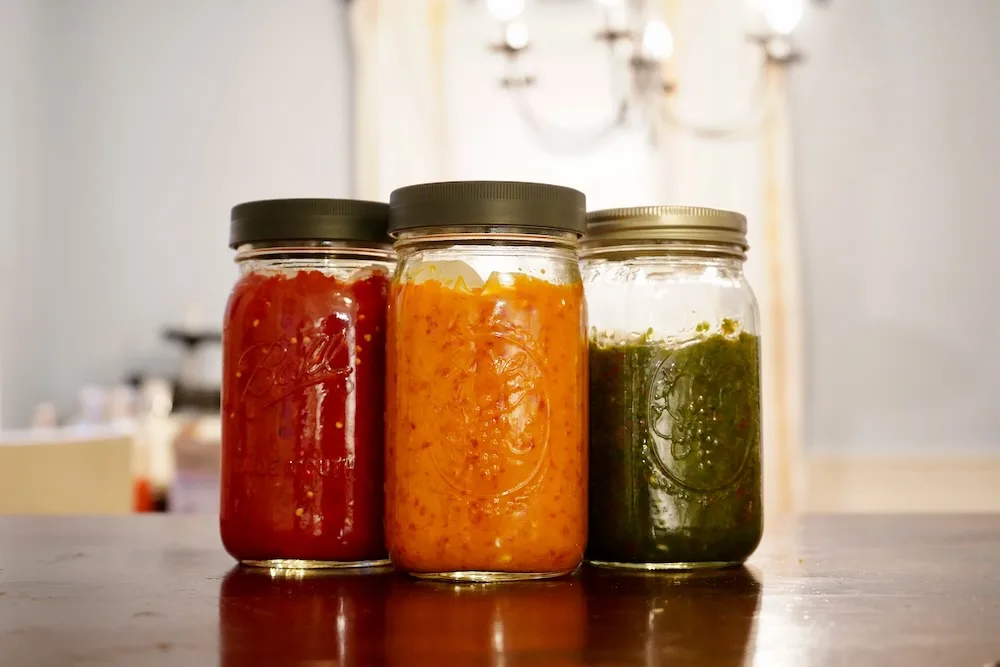
Mashes are great to use as a base for hot sauce, and may require the addition of more ingredients (vinegar, etc.) after fermentation. They also take up less space, as the produce is chopped before fermenting. This article will focus on this method of fermentation.
The other method is to create a salt brine and submerge whole or sliced produce in the salty liquid. This may be a slightly easier place to start, but can lead to issues if your peppers float to the surface.
The process of fermenting hot peppers is very simple. However, it is not a set-it-and-forget-it method of preservation. You will have to monitor your ferment on a daily basis to avoid any potential issues along the way.
Materials & Ingredients
- Glass jars
- Air lock lids (Get on Amazon)
- Kosher or sea salt (without iodine or anti-caking agents)
- Filtered water (chlorine-free)
- Hot peppers
- Fresh garlic (optional, but recommended)
- Other fresh produce (optional, such as carrots, onions, fruits, etc.)
- Kitchen scale
While you can use just peppers if you want, I like to add a few carrots, garlic cloves, and a bit of onion to improve the end flavor. Fermentation is all based on weight, so
How To Make Fermented Hot Sauce
This fermented hot sauce will use 4 basic ingredients: Peppers (jalapeño, ancho, and habanero), garlic, kosher salt, and water. You may add sugar or other flavorings to your liking.
- Prepare peppers.
Wash and dry your hot peppers. Cut off the tops and slice the peppers lengthwise. Remove seeds (optional). You can also slice the peppers into smaller pieces, but it is not necessary. Always wear gloves when handling spicy peppers!
- Sterilize jars.
I like to boil my glass jars to kill off some any bacteria that may be present. Boil the jars in a large pot for 10 minutes to ensure the jars are clean. Remove jars from boiling water and allow to full dry on a drying rack.

- Weigh the peppers and other produce.
Using a kitchen scale, weigh all of the peppers and other produce that will be fermented. Use grams as a unit of measure for precision.
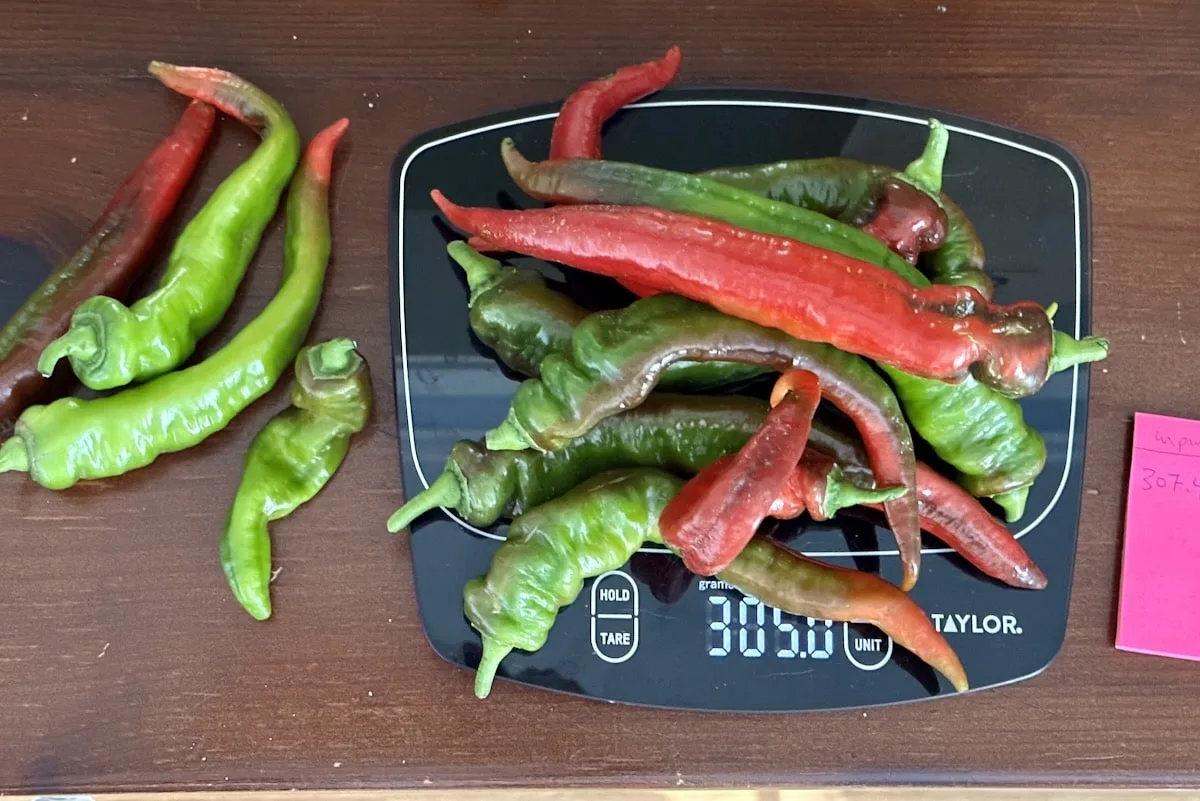
- Process with 2-4% salt.
Add the fresh peppers and other produce to a food processor. Based on the weight of your ingredients, add at least 2% salt. This is a very important safety measure to make sure other forms of bacteria can’t take hold in your ferment. Process the peppers and salt until finely chopped.

- Add to jars.
After processing, you should notice that the peppers release a small amount of liquid. Add the mash and liquid to clean glass jars, filling to about 1/2″ of the surface. Use a spoon to press the mash into the jars, releasing all air pockets (important). It is best to use jars that are appropriately sized for the amount of mash (not too much headspace).
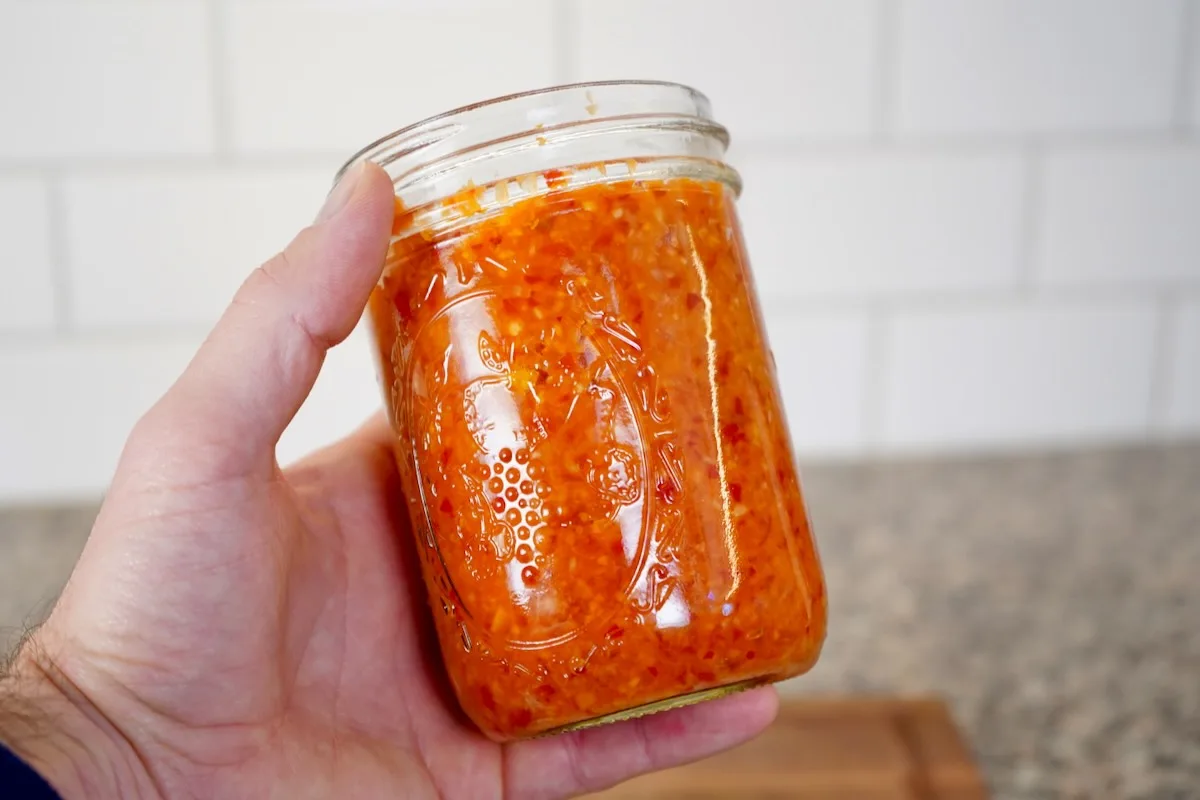
- Top with a cartouche (optional).
It is important that your mash does not come in contact with oxygen during fermentation. To avoid the surface growing mold, you can cover it with a cartouche. I cut a circle out of parchment paper the same size as the inside of the jar and press it onto the mash’s surface. You can also fill a plastic baggie with salted water and place it on the surface to block the air.
- Cover the jars with an airlock lid.
As fermentation takes place, CO2 will be released, causing a buildup of pressure. Airlock lids allow this pressure to release without allowing air to enter the jars. I prefer this to manually “burping” the jars, as this will avoid a possible explosion.

- Ferment for 3-4 weeks.
With this recipe, I have found that 3-4 weeks is the sweet spot for flavor and acidity. You can start checking for smell and flavor after the first 2 weeks or so and move on to the next step when you are happy. Important! Measure for pH with a good pH meter to ensure the brine is below 4.6. This is the pH at which botulinum toxin can no longer form and is a good minimum acidity to target.

- Add vinegar (optional).
After your ferment has reached a good flavor and aroma, it’s time to create your fermented hot sauce! I like to add a touch of vinegar to reach the right consistency, but this is optional. You can simply mix up your mash and use it as a thick condiment. If you want to add vinegar, add it in 1-2 tablespoon intervals, blending until your desired consistency is reached.
- Blend with high-powered blender.
To reach a smooth texture, blend in a high powered blender (we use this model). This will give the fermented hot sauce a velvety smooth feel and appearance.

- Bottle and refrigerate.
Unless your ferment is below pH 3.3, or you are planning to cook your sauce, it should be stored in the refrigerator. Refrigeration nearly halts the process of fermentation, preserving the desired flavor and preventing CO2 buildup. Use the original mason jar, or use a small funnel to fill hot sauce bottles.
Fermentation Brine (How To Get It Right)
If you want to try a brine fermentation, make sure you get the salt content correct. The goal is to have a 2-3% concentration of salt in the water by weight. Using grams, weigh both the water and the peppers/produce and multiply it by 0.025. Add at least that amount of salt to the mixture and dissolve thoroughly.
Tip: Be sure to factor in the amount of space your peppers will take up in the jars to avoid overfilling.
What pH Should My Fermented Hot Sauce Be?
We always test the pH of our fermented hot sauce to ensure it is adequately acidic. As fermentation takes place, the pH will drop lower and lower, becoming more and more acidic.
To put it simply, aim for a pH of 3.7 or lower when making fermented hot sauce. This ensures that your sauce will have a safe and long shelf life in the refrigerator. Some people target a pH of 3.5 for fermented hot sauce.
Technically, any pH below 4.6 will be stable, but we like to be cautious and allow our ferments to become very acidic before processing further.
- Test your hot sauce’s pH using a cheap pH meter like this one.
- We use a more reliable Apera meter – Get it here.
How To Lower pH of Hot Sauce
If your sauce is tasty, but the pH is too high, you can add vinegar to bring the pH lower. Add a few tablespoons of vinegar (white, white wine, apple cider, etc.), blend, and test the pH again. Once it is at or below 3.7, you can store it in the refrigerator.
How To Tell When Fermented Peppers Are Done
Fermentation will continue until you force it to slow by refrigerating. Foods fermented for longer tend to have a less sweet, more sour flavor. Each person will prefer a different level of fermentation.
In short, fermented peppers are done when they have a more sour, pungent aroma and flavor. After the first 2 weeks, test your ferment regularly until it has reached the desired flavor.
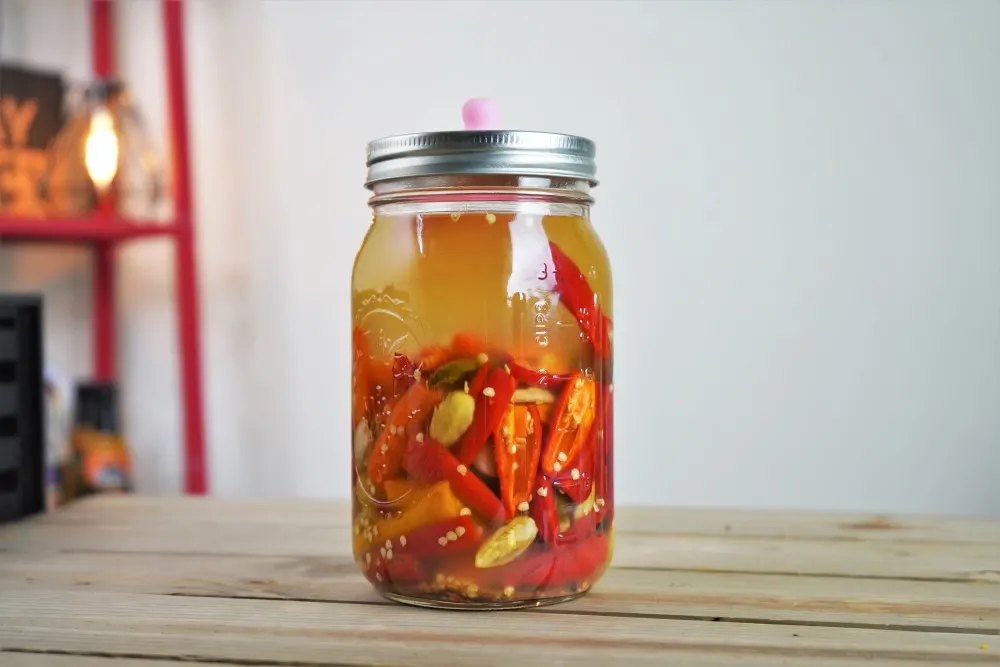
Some people prefer a longer ferment for a more *funky* flavor, while others like a short, milder ferment. You can ferment your sauce as long as you like, so long as it doesn’t grow mold or spoil. Add vinegar to shorter ferments to ensure they are acidic enough.
What Does Fermented Hot Sauce Taste Like?
You may not know it, but many of the most common table hot sauces are fermented. Ever heard of Tabasco? What about Frank’s RedHot? Yep, both use fermented pepper mash as a primary ingredient.
Fermented hot sauces have a slightly sour taste that is typical of many fermented foods. During fermentation, bacteria consumes sugars and other carbohydrates, reducing sweetness and developing a more acidic, sour flavor.
The reason for the slightly sour flavor is the production of lactic acid during the fermentation process. These acids replace sugars, and lead to a very distinctive flavor profile. The flavor of fermented hot sauce is difficult to describe in full, but it can be loosely described as slightly sour with an overall tangy character.
To really know how fermented hot sauce tastes, try making some yourself with our guide above!
How Long Will Fermented Hot Sauce Last?
Most fermented foods will last for months or even years when refrigerated. Over time, the flavor of your fermented hot sauce will continue to develop, often becoming more and more delicious. However, some people think that over-fermented foods can be a bit too pungent. Others love it (like me).
As a rule of thumb, homemade fermented hot sauce can last 2-3 months in the refrigerator.
I am comfortable allowing them to keep much longer, as it is difficult for them to go bad after properly fermenting. However, it is always wise to be on the safe side.
Always be sure to inspect your fermented sauce for mold growth or odd smells. If you are uncertain whether anything has gone wrong, you’re probably better off discarding.
What Is The White Stuff On My Fermentation?
There are a few things that a white substance on your ferment could be. The more common is harmless yeast that can simply be removed. The other might mean you need to discard your fermentation.
Kahm Yeast
This is very common and is harmless to your food. You can safely consume the yeast, but most choose to remove as much as they can with a clean spoon before storing the ferment in the refrigerator.
What causes kahn yeast?
There are a number of factors that can cause Kahm yeast to form on your ferment, but the most common are:
- Higher temperature
- Open-air fermentation (no closed lid)
- Fermenting sweeter vegetables, like peppers or carrots
This yeast is a live fungus that is common in the atmosphere and tends to thrive in a fermentation environment.
What does kahm yeast look like?

Kahm yeast can often be mistaken for mold, but if you use these simple identifiers, you will know whether your ferment is still safe:
- Stringy, wrinkled, film-like appearance
- White to off-white color
- Not fuzzy, but more flat
- Bubbles of carbon dioxide often get trapped in Kahm yeast
Mold
Mold is usually a reason to discard your ferment. There are ways to salvage a moldy ferment, but I prefer to simply call it a loss and start over.
What does mold look like on a ferment?

There are many types of mold, but most exhibit these similarities:
- Fuzzy appearance rather than smooth
- Raised from the surface
- Spotty at the beginning, eventually coming together to form a layer
There are some harmless molds, but it is hard to be sure without doing your own research. If you suspect you have mold, I recommend that you get rid of the ferment.
I definitely recommend throwing away your ferment if you see black, grey, orange, or pink colored molds. These colors may indicate harmful bacteria in your sauce.
Alternatively, you can simply skim away the top layer, careful to remove any and all visible mold. The remaining ferment should still be safe to eat.
Other Methods Of Preserving Hot Peppers
Want another option for preserving your hot peppers? There are tons! Check out our article on the many methods of preserving peppers here. You’ll learn how to pickle peppers, freeze them and lots of other cool tricks. Never let your peppers go to waste!
We hope you enjoyed this guide to making fermented hot sauce at home. Let us know how your sauce turned out, and if you recommend any other tasty ingredients to spice things up.
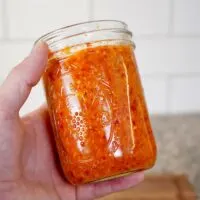
Fermented Hot Sauce
Equipment
- Glass jar
- Airlock lids optional, recommended
Ingredients
- 50 grams Hot peppers
- 150 grams Sweet peppers
- 150 grams Carrots
- 100 grams Sweet onion
- 3 cloves Garlic
- 12 grams Salt sea or kosher (2-3% by weight)
- Vinegar white or apple cider, ~5%
Instructions
Prepare the mash:
- Clean and dry the glass jars by boiling them (ideal), or washing with hot soapy water.
- Select the freshest ingredients available, as this can affect the success of fermentation.
- Weigh all of the fresh produce in grams and make a note of the total.
- Measure out 2-3% of the total weight of the produce in salt. For example, in this recipe, we need 12 grams of kosher salt for the ~460 grams of peppers, carrots, onions, and garlic.
- Rough chop the produce and add it to a food processor. Sprinkle the salt over the top.
- Blend the ingredients until they reach a finely chopped texture.
- Add the mash to the prepared glass jar, pressing it down to release all air pockets as you go. Any air left is a vulnerability for mold.
- Cover the mash with a cartouche (a piece of parchment cut to the size of the surface), pressing it into the surface to protect the top from air exposure.
- Cover the jars with an airlock lid and ferment for 3-4 weeks at room temperature.
Blend the hot sauce
- Once your fermented mash is finished, combine the mash with a small amount of distilled white vinegar (or your favorite type) in a blender.
- Add the vinegar 1 tablespoon at a time, blending as you go until the sauce is the desired consistency.
- Bottle the sauce and refrigerate for up to 3 months.
Notes
- After adding the mash to the jar, press down your ferment to release all air bubbles trapped within the ingredients. These can cause mold to grow within your ferment, spoiling it.
- Store the finished sauce in the refrigerator to avoid the bottles exploding as fermentation continues. Cold temperatures greatly slow the lacto-fermentation process.
- It is normal to see bubbles forming a few days after the ferment forms (these are CO2 and are a good sign that fermentation has begun).
- Smell and taste-test your ferment after about 2 weeks in a room-temperature location.
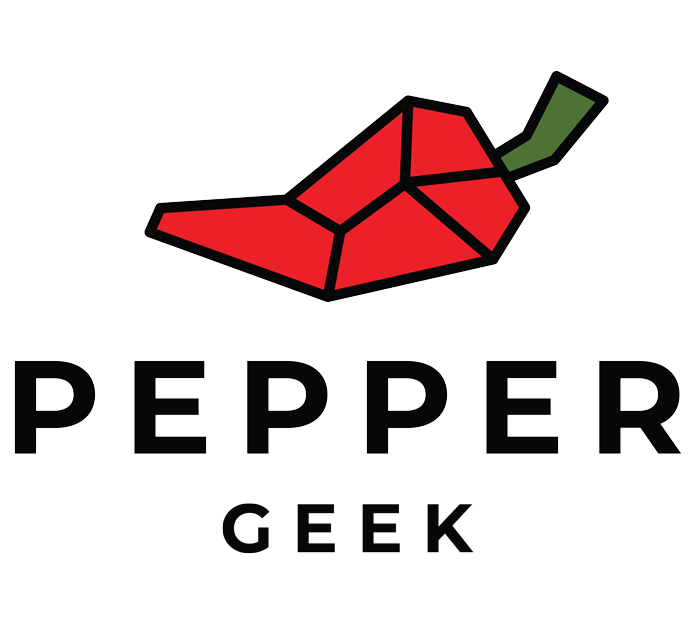

Charlie Franck
Saturday 16th of March 2024
I'm new to this process. How would the addition of fruit such as pineapple, cherries, or mango effect the fermentation?
peppergeek
Monday 18th of March 2024
Fruits are high in sugar content, meaning they provide more fuel for the fermentation process. In other words, it should be a more "active" ferment that requires more "burping" or CO2 release. I'd highly recommend using an airlock lid.
Robert
Saturday 6th of January 2024
Good info. But I have a question. I read another post about storing or shaking the ferment daily..... That sounds like trouble to me. Anyone out there do that? I have 4 going for about a month now and have only tilted the jars to enjoy watching the bubbles. Any info would be appreciated!
Cheryl
Tuesday 10th of October 2023
Do I need the amount of brine in the picture above my peppers? Also, if you wanted to add fruit to the sauce, such as apple or cranberry would that have to be fermented with the peppers?
Robert
Saturday 6th of January 2024
@Cheryl, Not a pro but yes we add fruit to enhance our ferments if it's too hot,etc
Daren
Sunday 1st of October 2023
Everyone I know who makes hot sauce uses the fermentation method, and after reading this it's still a mystery to me why anyone goes through all of this. I don't use salt for anything, I get enough without trying. "Brine?" No thanks. And after all of this it has to be refrigerated, and I don't find the finished product to compare favorably to mine. I make hot sauces with vinegar and peppers and no other ingredients and use the stove top method. The many who have tried it love it, it has great flavor and as much heat as anyone can stand for my hottest sauces. Right now I'm working on a bottle I made two years ago that's been in my cabinet unrefrigerated until I cracked into it. I've used older stuff than that and no one can tell the difference between 3 years old and 3 days old. PH level is slightly above or below 4. Takes me about a half an hour to make a batch. I usually age it for a minimum of 3 days under refrigeration, but I'm not sure that's necessary.
Muncy Coogins
Thursday 19th of October 2023
@Daren, cool. You're probably hanging around the wrong page then...
Vaudo Aridas, Rosemarie
Monday 11th of September 2023
How can commercial hot sauces be stored on shelves? Is there another process they employ?
peppergeek
Tuesday 12th of September 2023
Yes, a combination of heating to a high temperature and low pH